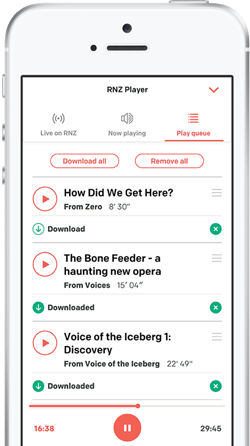The New Zealand Symphony Orchestra tours the length of the country to perform some of the most popular and beloved works of classical music by the great composers Franz Schubert, Claude Debussy and Pyotr Tchaikovsky, as well as the world premiere of a new work by acclaimed New Zealand composer Gillian Whitehead.
Schubert’s instantly recognisable Symphony No. 8 ‘Unfinished Symphony’, Debussy’s haunting Prelude a l’apres-midi d’un faune, and Tchaikovsky’s mesmerising Variations on a Rococo Theme and his magnificent Romeo and Juliet Fantasy Overture are perpetual audience favourites. These pieces are often used in movies and television, so will be familiar to many people new to the orchestra.
Programme:
Schubert: Symphony No 8 in B Minor D759, 'Unfinished';
Tchaikovsky: Variations on a Rococo Theme Op 33;
Whitehead: Turanga-nui;
Debussy: Prélude à l'après-midi d'un faune;
Tchaikovsky: Romeo & Juliet Fantasy Overture
Andrew Joyce (cello), New Zealand Symphony Orchestra conducted by Hamish McKeich.
Recorded in Michael Fowler Centre, Wellington
Find out more and listen to this performance here:
SCHUBERT: Symphony No 8 in B minor, Unfinished
Franz Schubert made something of a habit of not finishing symphonies.

Hamish McKeich Photo: Tracey Valerie
This is one of four symphonies where sections or whole movements were begun and then abandoned. The two movements were composed in October 1822 at a time when the 25-year-old Schubert was enjoying his first tastes of success. The reason he laid the work aside are not clear. Perhaps, as conductor Nikolaus Harnoncourt is convinced, the piece remained unfinished because 'the form is perfect; there is nothing more to say'.
Recorded 15 September 2018, Michael Fowler Centre, Wellington by RNZ Concert
Producer: David McCaw
Engineer: Graham Kennedy
TCHAIKOVSKY: Variations on a Rococo Theme
A nostalgia for the refined and elegant world of the 18th century is never from from the surface in the highly romantic art of Tchaikovsky.

NZSO's Andrew Joyce Photo: Supplied
Mozart was the composer who symbolised the best of the former century for Tchaikovsky. "No one," he said, "has so made me weep and tremble with rapture at nearness to what we call the ideal."
This set of theme & variations for cello and orchestra is meant as a tribute to his hero Mozart. They are charming, elegant, and gratifying for both cellists and audiences.
Recorded 15 September 2018, Michael Fowler Centre, Wellington by RNZ Concert
Producer: David McCaw
Engineer: Graham Kennedy
Gillian WHITEHEAD: Turanga-nui (première)
Two hundred and fifty years ago, on 8 October 1769, Captain Cook and his men, with the best of intentions, made landfall in the Endeavour, in the east coast harbour of Turanga-nui-a-kiwa, modern day Gisborne.

Gillian Whitehead Photo: Gareth Watkins/Lilburn Trust/Wallace Arts Trust.
New Zealand Symphony Orchestra, conducted by Hamish McKeich
They went ashore to find water, but unfortunately things did not go to plan. As a result of cultural misunderstandings, that day the first shots were fired in this country, and four Maori lost their lives.
Composer Gillian Whitehead says, "While writing this piece, I considered what Cook and his party, and Maori arriving here centuries earlier, would have felt - relief and elation at being on dry land, alongside heightened awareness, apprehension, wonder, fear. And for the iwi on shore, curiosity, apprehension maybe, but no foreknowledge of how the visitors would threaten and change their world order.
Turanga-nui is part abstract, part programmatic (given the theme of landfall how could it not be?) and I leave it to listeners to interpret it in their own way."
Recorded 15 September 2018, Michael Fowler Centre, Wellington by RNZ Concert
Producer: David McCaw
Engineer: Graham Kennedy
DEBUSSY: Prélude à l'après-midi d'un faune
Poet Stéphane Mallarmé published his Prélude à l'après-midi d'un faune in 1876. Its sumptuous but fragmentary language reflects the erotic fantasies of a drowsy faun - a mythical half-man/half-goat - on a hot Sicilian afternoon.

Claude Debussy ca 1908 Photo: Public domain
New Zealand Symphony Orchestra conducted by Hamish McKeich
Running like a thread through the poem's imagery of fruit and flowers and naked nymphs are references to music, specifically the syrinx, or pan-pipes. One of these references inspired Debussy and when he invited Mallarmé to hear his work in 1894, he described 'the arabesque which ... I believe to have been dictated by the flute of your faun.'
Recorded 15 September 2018, Michael Fowler Centre, Wellington by RNZ Concert
Producer: David McCaw
Engineer: Graham Kennedy
TCHAIKOVSKY: Romeo and Juliet Fantasy Overture
Shakespeare's young hero and heroine, whose families are implacable enemies become classic star-crossed lovers.

Statue of Tchaikovsky near his garden at Klin Photo: CC BY-SA 3.0
New Zealand Symphony Orchestra conducted by Hamish McKeich
Many composers have been inspired to write music for the young lovers' story.
Tchaikovsky's 'Romeo and Juliet Fantasy Overture' of 1869 is his supreme early orchestral achievement. The music begins with a hymn-like introduction suggesting Friar Laurence's cell, then the Capulets and Montagues feud in a fiery passage, giving way to the love scene. A furious climax may be the death of Tybalt at the hand of Romeo, but the love music dominates the ending, turning gradually to lament and tragic despair.
Recorded 15 September 2018, Michael Fowler Centre, Wellington by RNZ Concert
Producer: David McCaw
Engineer: Graham Kennedy
WOOD: Tom Bowling, from Fantasia on British Sea Songs (encore)

NZSO's Andrew Joyce Photo: Supplied
Andrew Joyce & New Zealand Symphony Orchestra conducted by Hamish McKeich.
Recorded 15 September 2018, Michael Fowler Centre, Wellington by RNZ Concert
Producer: David McCaw
Engineer: Graham Kennedy

